三角函数
1 三角函数
1.1 任意角
初中学的角度全都是从 0~360°,而高中最大的进步就是拓展了角度的范围,可以从负无穷到正无穷。
(1)任意角的定义:一条射线绕着端点在平面内旋转而成的图形,角的大小就是转过的角度,角的正负就是旋转的方向(逆时针为正)。
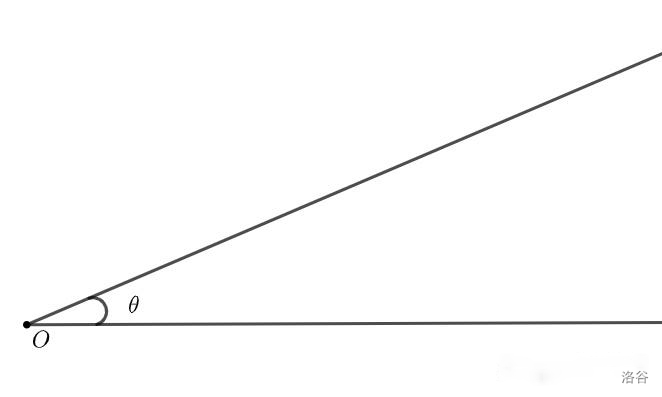
就像这个角是 \(\theta\) ,大家不要被迷惑,以为它看上去就是大约 20°,他也有可能是 380°(先逆时针转 360° 回到原位置,再逆时针转 20°),甚至有可能是 -340°(顺时针转一圈不到 20°),还有更多可能。
(2)任意角的正负:强调一下逆时针为正。
(3)任意角的象限:
其实就是把这条射线的初始位置放到 \(x\) 轴,并且把原点和射线的起点重合。因此每一个角都会落在某个象限或者某个坐标轴上。
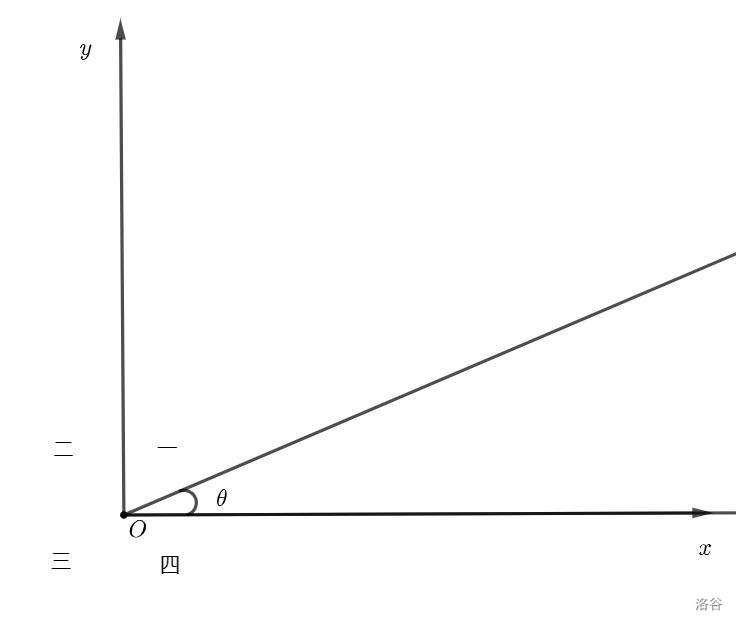
此时的角就落在第一象限
1.2 弧度制
弧度制的作用就是更方便地求弧长。除此之外它就打不过角度制了。
(1)定义:弧长和半径相等的圆心角就是 1 弧度的角。单位为 rad,读作弧度,这种用“弧度”来表示角度的方法叫做弧度制。
(2)弧长计算公式
\[l=\theta R\\
\]
能够更加方便地求出弧长,这就是弧度制最大的魅力。
(3)弧度制和角度制的转换:
\[2\pi=360° \Longrightarrow\pi=180° \Longrightarrow\frac{\pi}{2}=90° \\\Longrightarrow\frac{\pi}{4}=45°\Longrightarrow\frac{\pi}{3}=60°\Longrightarrow\frac{\pi}{6}=30°
\]
1.3 任意角的三角函数
(1)定义:设 \(\theta\) 是一个任意角,它的终边和单位圆的交点为 \(P(a,b)\) ,如图:
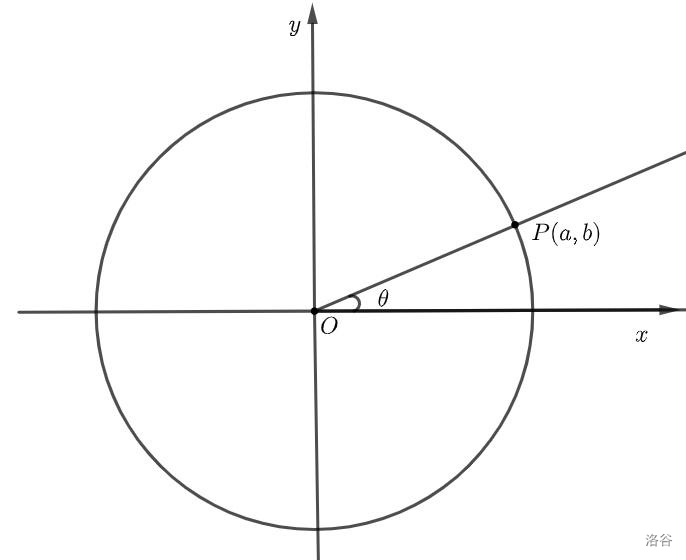
\[\sin{\theta}=b,\cos{\theta}=a,\tan{\theta}=\frac{b}{a}\\
\]
注:
①三个三角函数都有可能是负值,具体取决于 \(a\) 和 \(b\) 的正负。
②正弦和余弦的定义域是 \(R\) ,但是正切的定义域为 \(\{\theta|\theta\ne k\pi+\frac{\pi}{2},k\in Z\}\)
1.4 诱导公式
对于三角函数,根据它的定义,有下列诱导公式
\[\sin(\alpha+k\cdot 2\pi)=\sin\alpha,\cos(\alpha+k\cdot 2\pi)=\cos\alpha,\tan(\alpha+k\cdot 2\pi)=\tan\alpha\\[5pt]
\sin{(-\alpha)}=-\sin{\alpha},\cos{(-\alpha)}=\cos{\alpha},\tan{(-\alpha)}=-\tan{\alpha}\\[5pt]
\sin{(\pi\pm\alpha)}=\mp\sin{\alpha},\cos{(\pi\pm\alpha)}=-\cos{\alpha},\tan{(\pi\pm\alpha)}=\pm\tan{\alpha}\\[5pt]
\sin{(\frac{\pi}{2}\pm\alpha)}=\cos{\alpha},\cos{(\frac{\pi}{2}\pm\alpha)}=\mp\sin{\alpha},\tan{(\frac{\pi}{2}\pm\alpha)}=\mp\cot{\alpha}\\[5pt]
\]
通过上面的公式我们就可以把所有的角都化为一个锐角了,锐角处理起来还不是有手就行。至于推导的话主要遵循一个口诀:奇变偶不变,符号看象限。
怎么理解“奇变偶不变,符号看象限”?
诱导公式可概括为角 \(k\cdot\displaystyle\frac{\pi}{2}\pm\alpha(k\in\Z)\) 的各三角函数值的化简公式。奇与偶指角 \((k\cdot\displaystyle\frac{\pi}{2}\pm\alpha)\) 中 \(\displaystyle\frac{\pi}{2}\) 的倍数 \(k\) 的奇偶;变与不变指的是三角函数名,变是指正弦变余弦、余弦变正弦,不变是指三角函数名不变;符号看象限是指把角 \(\alpha\) 看成锐角时原函数值的符号.
1.5 三角函数的图像
我们可以画出三角函数的图像,例如
\(y=2\sin{(x+\displaystyle\frac{\pi}{3})}\) 的图像为
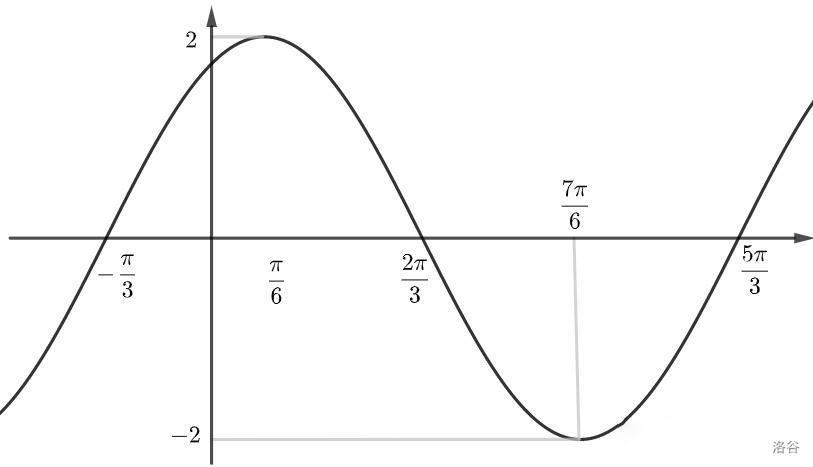
在数学中,这是典型的五点法作图。
更多具体的图像我们留到振动和波动章节再细说。
2 三角恒等变换
2.1 三角恒等变换的基本概念
三角恒等变换是数学的一类公式,用于三角等价变化。咳咳咳,最重要的其实还是在同学面前装13,接下去的内容两角和差公式以及辅助角公式需要牢牢掌握,和差化积、积化和差以及万能公式就可以记下来在同学面前装13了。
2.2 两角和差公式
\[\sin(\alpha\pm\beta)=\sin\alpha\cos\beta\pm\cos\alpha\sin\beta,
\cos(\alpha\pm\beta)=\cos\alpha\cos\beta\mp\sin\alpha\sin\beta\\[5pt]
\tan(\alpha\pm\beta)=\frac{\tan\alpha\pm\tan\beta}{1\mp\tan\alpha\tan\beta}\Rightarrow\tan\alpha\pm\tan\beta=\tan(\alpha\pm\beta)(1\mp\tan\alpha\tan\beta)\\[5pt]
\]
这是最最最最重要的公式,一定要背下来。就像张无忌的九阳神功,没有九阳神功他也学不会乾坤大挪移。
2.3 辅助角公式
(1)作用
辅助角公式常用来求极值。
(2)辅助角公式
\[a\sin{\alpha}+b\cos{\alpha}=\sqrt{a^2+b^2}\sin(\alpha+\varphi)\\[5pt]
\sin{\varphi}=\frac{b}{\sqrt{a^2+b^2}},\cos{\varphi}=\frac{a}{\sqrt{a^2+b^2}},\tan{\varphi}=\frac{b}{a}\\[5pt]
\]
【例题】求函数 \(f(x)=(1+\sqrt3\tan{x})\cos{x}(x\in R)\) 的最大值。
【解析】
\[f(x)=\cos{x}+\sqrt3\sin{x}=2\sin{(x+\frac{\pi}{6})}\\ \therefore f_{max}=2
\]
2.4 二倍角公式
\[\sin{2\alpha}=2\sin\alpha\cos\alpha\Rightarrow 1\pm\sin2\alpha=\sin^2\alpha+\cos^2\alpha\pm2\sin\alpha\cos\alpha=(\sin\alpha\pm\cos\alpha)^2\\[5pt]
\cos{2\alpha}=\cos^2{\alpha}-\sin^2{\alpha}=2\cos^2{\alpha}-1=1-2\sin^2{\alpha},\tan{2\alpha}=\frac{2\tan{\alpha}}{1-\tan^2{\alpha}}\\[5pt]
\]
【例题】求函数 \(f(\alpha)=\displaystyle\frac{1}{2}\cos{2\alpha}+\cos{\alpha}(x\in[0,2\pi])\) 的最小值。
【解析】
\[f(\alpha)=\frac{1}{2}\cos{2\alpha}+\cos{\alpha}=\frac{1}{2}(2\cos^2{\alpha}-1)+\cos{\alpha}\\
=\cos^2{\alpha}+\cos{\alpha}-\frac{1}{2}=(\cos{\alpha}+\frac{1}{2})^2-\frac{3}{4}\\
\therefore f_{min}=-\frac{3}{4}
\]
2.5 升幂、降幂公式
\[1+\cos\alpha=2\cos^2\frac{\alpha}{2},1-\cos\alpha=2\sin^2\frac{\alpha}{2}\\[5pt]
\cos^2\alpha=\frac{1+\cos2\alpha}{2},\sin^2\alpha=\frac{1-\cos2\alpha}{2}\\[5pt]
\]
2.6 半角公式
\[\sin\frac{\alpha}{2}=\pm\sqrt{\displaystyle\frac{1-\cos\alpha}{2}},\cos\frac{\alpha}{2}=\pm\sqrt{\displaystyle\frac{1+\cos\alpha}{2}}\\[5pt]
\tan\frac{\alpha}{2}=\pm\sqrt{\displaystyle\frac{1-\cos\alpha}{1+\cos\alpha}}=\frac{\sin\alpha}{1+\cos\alpha}=\frac{1-\cos\alpha}{\sin\alpha}\\[5pt]
\]
2.7 万能公式
\[\sin{\alpha}=\frac{2\tan{\displaystyle\frac{\alpha}{2}}}{1+\tan^2{\displaystyle\frac{\alpha}{2}}},\cos{\alpha}=\frac{1-\tan^2{\displaystyle\frac{\alpha}{2}}}{1+\tan^2{\displaystyle\frac{\alpha}{2}}},\tan{\alpha}=\frac{2\displaystyle\tan{\frac{\alpha}{2}}}{1-\tan^2{\displaystyle\frac{\alpha}{2}}}\\
\]
2.8 积化和差
\[\sin{\alpha}\cos{\beta}=\frac{1}{2}[\sin{(\alpha}+\beta)+\sin{(\alpha}-\beta)]\\[5pt]
\cos{\alpha}\sin{\beta}=\frac{1}{2}[\sin{(\alpha}+\beta)-\sin{(\alpha}-\beta)]\\[5pt]
\cos{\alpha}\cos{\beta}=\frac{1}{2}[cos{(\alpha}+\beta)+\cos{(\alpha}-\beta)]\\[5pt]
\sin{\alpha}\sin{\beta}=-\frac{1}{2}[cos{(\alpha}+\beta)-\cos{(\alpha}-\beta)]\\[5pt]
\]
证明:
emm证明的话其实和差化积和积化和差可以互证(把和差化积的 \(\alpha\) 换为 \(\alpha+\beta\) , \(\beta\) 换为 \(\alpha-\beta\) 就得到了积化和差,其实用两角和差公式展开就行了)
\[\frac{1}{2}[\sin{(\alpha}+\beta)+\sin{(\alpha}-\beta)]\\ =\frac{1}{2}[\sin\alpha\cos\beta+\cos\alpha\sin\beta+\sin\alpha\cos\beta-\cos\alpha\sin\beta]\\ =\frac{1}{2}[2\sin\alpha\cos\beta]=\sin\alpha\cos\beta
\]
后面的三个公式就不证明了,证明方法相同。需要知道的是,其实积化和差、和差化积公式都是从最基础的两角和差公式推演过来的,因此大家需要把握住两角和差公式。
【例题】若 \(\cos{(\alpha+\beta)}\cos{(\alpha-\beta)}=\displaystyle\frac{1}{3}\) ,求 \(\cos^2{\alpha}-\sin^2{\beta}\) 。
【解析】
根据积化和差公式的第三个公式
\[\cos{(\alpha+\beta)}\cos{(\alpha-\beta)}=\frac{1}{2}(\cos{2\alpha}+\cos{2\beta})\\
=\frac{1}{2}(2\cos^2{\alpha}-1+1-2\sin^2{\beta})=\cos^2{\alpha}-\sin^2{\beta}=\frac{1}{3}
\]
2.9 和差化积公式
\[\sin{\alpha}+\sin{\beta}=2\sin{\frac{{\alpha}+\beta}{2}}\cos{\frac{{\alpha}-\beta}{2}}\\[5pt]
\sin{\alpha}-\sin{\beta}=2\cos{\frac{{\alpha}+\beta}{2}}\sin{\frac{{\alpha}-\beta}{2}}\\[5pt]
\cos{\alpha}+\cos{\beta}=2\cos{\frac{{\alpha}+\beta}{2}}\cos{\frac{{\alpha}-\beta}{2}}\\[5pt]
\cos{\alpha}-\cos{\beta}=-2\sin{\frac{{\alpha}+\beta}{2}}\sin{\frac{{\alpha}-\beta}{2}}\\[5pt]
\]
3 解三角形
三角形是大家见到的最基础的图形,那么它的三条边和三个角有什么关系呢?一般我们把三条边记为 \(a,b,c\) ,三条边的 对角记为 \(A,B,C\) ,这一小节我们将介绍三角形中两个基本定理:正弦定理和余弦定理。
3.1 正弦定理
3.1.1 内容
\[\frac{a}{\sin{A}}=\frac{b}{\sin{B}}=\frac{c}{\sin{C}}=2R\\
\]
其中 \(R\) 是三角形内接圆的半径。
3.1.2 证明
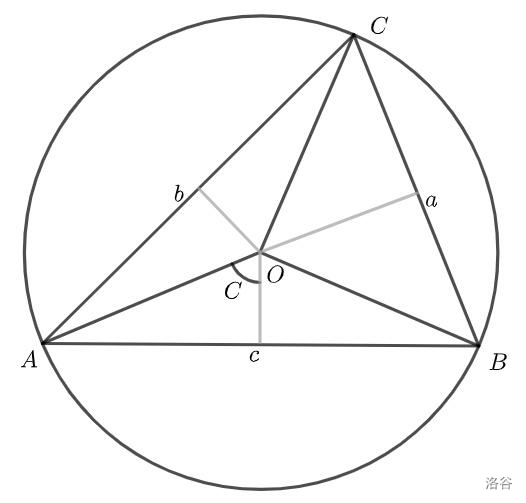
根据圆周角和圆心角的关系\(\angle{AOB}=2C\),因此 \(\overline{AB}=c=2R\sin{C}\) ,所以我们就能得到 \(\frac{\displaystyle c}{\displaystyle\sin{C}}=2R\),其他边的证明同理。
证毕。
3.2 余弦定理
3.2.1 内容
\[\begin{aligned}
a^2&=b^2+c^2-2bc\cos{A}\\[5pt]
b^2&=c^2+a^2-2ac\cos{B}\\[5pt]
c^2&=a^2+b^2-2ab\cos{C}\\[5pt]
\end{aligned}
\]
还有一些推论
\[\begin{aligned}
\cos a&=\frac{b^2+c^2-a^2}{2bc}\\[5pt]
\cos b&=\frac{a^2+c^2-b^2}{2ac}\\[5pt]
\cos c&=\frac{a^2+b^2-c^2}{2ab}\\[5pt]
\end{aligned}
\]
注:勾股定理其实只是余弦定理的特例,现在能够感受到余弦定理的厉害之处了吧。
3.2.2 证明
在 \(\triangle ABC\) 中由 \(\vec{CB}=
\vec{AB}-\vec{AC}\) 可得
\[\begin{aligned}
\vec{CB}\cdot\vec{CB}=&(\vec{AB}-\vec{AC})\cdot(\vec{AB}-\vec{AC})\\
=&\vec{AB}^2+\vec{AC}^2-2\vec{AB}\cdot\vec{AC}\\
=&b^2-c^2-2bc\cos A
\end{aligned}
\]
即 \(a^2=b^2-c^2-2bc\cos A\),其他边的证明同理。
证毕。
3.3 一些应用
\[S\triangle ABC=\frac{1}{2}ab\sin C=\frac{1}{2}ac\sin B=\frac{1}{2}bc\sin A
\]
还有些别的先待我先学习学习再补充。







 浙公网安备 33010602011771号
浙公网安备 33010602011771号